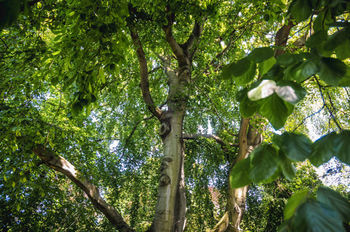Beech
From Wikiwel
Other Names : Fagus, Fagus grandifolia, Fagus hayatae, Fagus mexicana, Fagus sylvatica, Fagus longipetiolata
Beech is a genus of deciduous trees in the family Fagaceae, native to temperate Europe, Asia and North America. The genus Fagus comprises more than a dozen different species.
Special Precautions of Beech
Beechnuts do have certain toxins that should not be consumed in large quantities, so if you aren’t trained to know what type of tree and what part of the tree is used in what capacity, don’t attempt to “forage” alone. Speak to a professional botanist, herbalist, or medical professional before adding any major beech treatments to your regimen.
Health Benefits and uses of Beech are
- Hair Growth: The unique chemical composition of beechnuts has been said to be stimulating for hair growth and strengthening of the hair follicle beds. If you suffer from hair loss or brittle hair, the oil extracted from these nuts can be added to a carrier oil and used on the hair to boost its appearance and strength.
- Newborn Health: The significant levels of vitamin B6 found in beechnuts makes it a wonderful addition for pregnant mothers who want to ensure the health of their baby. Vitamin B6, also known as folate or folic acid, is an essential vitamin to prevent neural tube defects in infants, so adding some beechnuts to your diet is never a bad idea. However, only in moderation, as beechnuts do have certain toxins that should not be consumed in large quantities.
- Digestion: Although eating the leaves off trees is not a particularly common practice, beech tree leaves and shoots have been eaten for hundreds (if not thousands) of years, particularly in times of famine. The high cellulose and fiber content is good for regulating digestion and offers a viable “foraging food” if that becomes necessary on hikes, camping trips, etc.
- Headaches and Pain Relief: The leaves can also be boiled down to create a poultice or a salve with proven analgesic properties. In traditional medicine, beech tree poultices were relied on to treat headaches and other mild pain-related issues, and is still included in certain herbal analgesics on the market today. This works for both topical application and oral consumption.
- Antioxidant Potential: The idea of eating tree bark might not strike many of you as an attractive prospect, but the bark of beech trees are rich in lignans and other antioxidant substances that can be a major boost to your immune system. Antioxidants can neutralize free radicals that cause chronic disease and cell mutation, including cancer. By drying the bark and treating it properly, it becomes a viable source of hugely beneficial antioxidant compounds!
- Kidney Disorders: Although the seeds themselves are considered toxic in large quantities, a decoction can be made that is shown to significantly boost kidney function and stimulate urination. As a diuretic, beech is able to help clear out the toxins of the body, including excess fats, salt, waste, and water, improving the overall efficiency of your metabolism.
- Antiseptic: The branches can be distilled down (dry distillation) to produce a type of tar or creosote, which can be topically applied to wounds in order to protect them from infections and microbes. This sticky substance can also be applied to the skin to improve its appearance, reduce the signs of scarring and aging, and soothe inflammation. Furthermore, research has shown it to be a good treatment for eczema, psoriasis, boils, frostbite, and burns.
- From the tree bark, once used in pharmacy, could be extracted a creosote syrup, used to disinfect respiratory tracks.
- Gemmotherapy : an area of phytotherapy that uses buds and young shoots of trees and shrubs. Its buds are harvested over a very short and precise period of time (1 to 2 weeks) when they are particularly rich in phytostimulines, plant hormones stimulating the blooming and growing of the buds. The buds are harvested on the lowest branches so the tree further development is not slowed down. Discovered by Dr. Henry, a homeopathic doctor from Brussels passionated about alchemy, beech buds harbor growth hormones gifted with stimulating properties on the cellular metabolism and allowing the bud to shift from its dormant state to full bloom.This could explain the potential action of the buds against cell aging, specially within the endocrine system. Beech bud extract also has a draining effect on the lymphatic system, and is often used in cosmetics to fight against cellulite and water retention. But the more spectacular results are with no doubt its rejuvenating and smoothing effect on the skin by stimulating the renewal of the upper layers of the epidermis. And like all plant buds, beech buds offer an antiaging action thanks to its protein-rich composition and plant growth hormones
